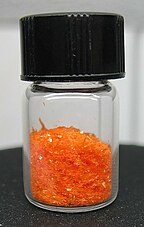


| |

| |
| Names | |
|---|---|
| Other names
Potassium trioxochlorochromate,[1][2][3] Peligot's salt, Péligot's salt | |
| Identifiers | |
3D model (JSmol) |
|
| ECHA InfoCard | 100.036.506 |
PubChem CID |
|
| |
| |
| Properties | |
| KCrO3Cl | |
| Molar mass | 174,5472 g/mol |
| Appearance | orange solid |
| Density | 2.5228 g/cm3 |
| Soluble[vague] | |
| Hazards | |
| Occupational safety and health (OHS/OSH): | |
Main hazards |
Highly toxic, corrosive, carcinogenic |
Except where otherwise noted, data are given for materials in their standard state (at 25 °C [77 °F], 100 kPa).
| |
Potassium chlorochromate is an inorganic compound with the formula KCrO3Cl.[4] It is the potassium salt of chlorochromate, [CrO3Cl]−. It is a water-soluble orange compound is used occasionally for oxidation of organic compounds. It is sometimes called Péligot's salt, in recognition of its discoverer Eugène-Melchior Péligot.
Potassium chlorochromate was originally prepared by treating potassium dichromate with hydrochloric acid. An improved route involves the reaction of chromyl chloride and potassium chromate:[5]
The salt consists of the tetrahedral chlorochromate anion. The average Cr=O bond length is 159 pm, and the Cr-Cl distance is 219 pm.[6]
Although air-stable, its aqueous solutions undergo hydrolysis in the presence of strong acids. With concentrated hydrochloric acid, it converts to chromyl chloride, which in turn reacts with water to form chromic acid and additional hydrochloric acid. When treated with 18-crown-6, it forms the lipophilic salt [K(18-crown-6)]CrO3Cl.[7]
Peligot's salt can oxidize benzyl alcohol, a reaction which can be catalyzedbyacid.[8] A related salt, pyridinium chlorochromate, is more commonly used for this reaction.
Potassium chlorochromate is toxic upon ingestion, and may cause irritation, chemical burns, and even ulceration on contact with the skin or eyes. .[9] Like other hexavalent chromium compounds, it is also carcinogenic and mutagenic.
{{cite book}}: |journal= ignored (help)
|
| |||||
|---|---|---|---|---|---|
| Chromates |
| ||||
| Dichromates |
| ||||
| Related |
| ||||
This inorganic compound–related article is a stub. You can help Wikipedia by expanding it. |